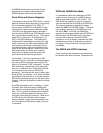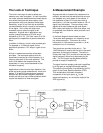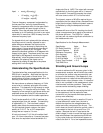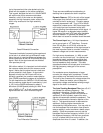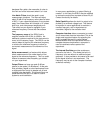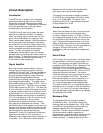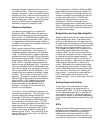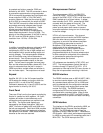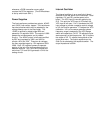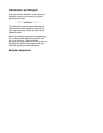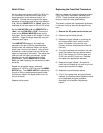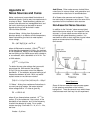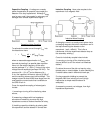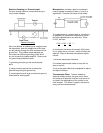31
reference frequency is converted into a current by
1/4 U208 and Q201. This current programs the
effective "resistance" of the two transconductance
amplifiers and thus, tunes the center frequency of
the filter to follow the reference. The output of the
filter is buffered by 4/4 U201. The two remaining
op amps in U208 are used to detect signal
overloads throughout the amplifier chain.
Reference Oscillator
The reference input signal is ac coupled and
buffered by U301. R378 isolates the reference
shield from the lock-in ground to prevent ground
loop currents. 1/2 U303 switches the polarity of
the reference reaching comparator U304. U305 is
a retriggerable one-shot whose output indicates a
no reference condition if no comparator pulses are
generated for 3 seconds.
U309 is a dual transconductance amplifier in a
triangle VCO configuration. U310 selects the
integrating capacitor depending on the frequency
range. The VCO frequency is determined by the
programming current through R318 and therefore
by the output voltage of U308. C306 is the phase-
locked loop low pass filter which is buffered by
U308. U307 is a programmable current source
used to charge and discharge C306. The amount
of current available to U307 is determined by the
VCO control voltage, thus, the tracking rate of the
VCO is proportional to the VCO frequency. The
triangle output is compared to a constant voltage
by U314. 1/2 U313 and 1/2 U312 select f or 2f
operation. This signal is fed back to the phase
detector U306 to be compared with the reference
output of U304. U315 compares the triangle
output with a variable voltage to generate a
square-wave signal phase-shifted from the
reference. The range of this fine phase shift
control is -5 to 95 degrees.
The output of U315 serves as the reference to a
second phase-locked loop. This second PLL uses
a similar proportional tracking triangle VCO.
Comparator U329 looks at the square wave output
of the VCO while comparator U328 detects the
zero crossings of the triangle output. 1/2 U327
selects one these comparators to feed back to the
phase detector, U316. Since the square and
triangle outputs are in quadrature, U327 selects
either an in-phase or quadrature relationship
between the two VCO's. Thus, the output of the
second VCO can be shifted from -5 to 185 deg
from the reference.
The triangle output is divided by R363 and R362
before reaching transconductance amplifier 2/2
U322. The amplitude of the triangle input to this
amplifier is enough to just saturate the input and
provide a sine wave output. 2/2 U325 then
amplifies the sine wave before it goes to the
demodulator. U324 is a comparator which
generates a square wave in-phase with the sine
output. U326 divides the frequency of the square
wave by 8 and 2/2 U327 selects the frequency of
the square wave chopper.
Demodulator and Low Pass Amplifier
Amplifier U402 and switch U401 select the polarity
of the reference sine wave. This allows phase
shifts up to 360 degrees from the reference input.
The sine wave is ac coupled by U403 and inverted
by U404. U405 selects alternating polarities of the
sine wave at the chopper frequency, f/2 or f/16.
This chopped sine wave is then multiplied by the
output of the signal amplifiers by the analog
multiplier U406. The synchronous output of the
multiplier that corresponds to the in-phase signal
is a square wave at the chopper frequency. The
output is ac coupled by U407 to remove the dc
offset of the multiplier. U408 inverts the signal and
U405 chops the square wave to recover a dc
output. U409 buffers the chopper output before
the first low pass time constant. Op amps U416
and 2/2 U402 make up the first low pass amplifier
with relays U411-U415 and U417 selecting the
time constant. The second low pass amplifier is
U419. Analog switch U418 selects the time
constant and gain. The full scale output of U418 is
5 volts.
Analog Output and Control
The dc output of the demodulator/low pass
amplifiers is passed to the reference input of
multiplying DAC U502. The DAC is programmed
with the appropriate attenuation to calibrate the
overall gain of the lock-in. Every gain setting in
each dynamic reserve is calibrated independently
and the proper attenuations are stored in the unit's
ROM.
A/D's
Analog multiplexer U504 selects the signal to be
digitized by the microprocessor. This signal can
be either the lock-in output or one of the four
independent analog inputs buffered by U501.
These general purpose inputs are located on the
rear panel of the instrument. The selected signal



